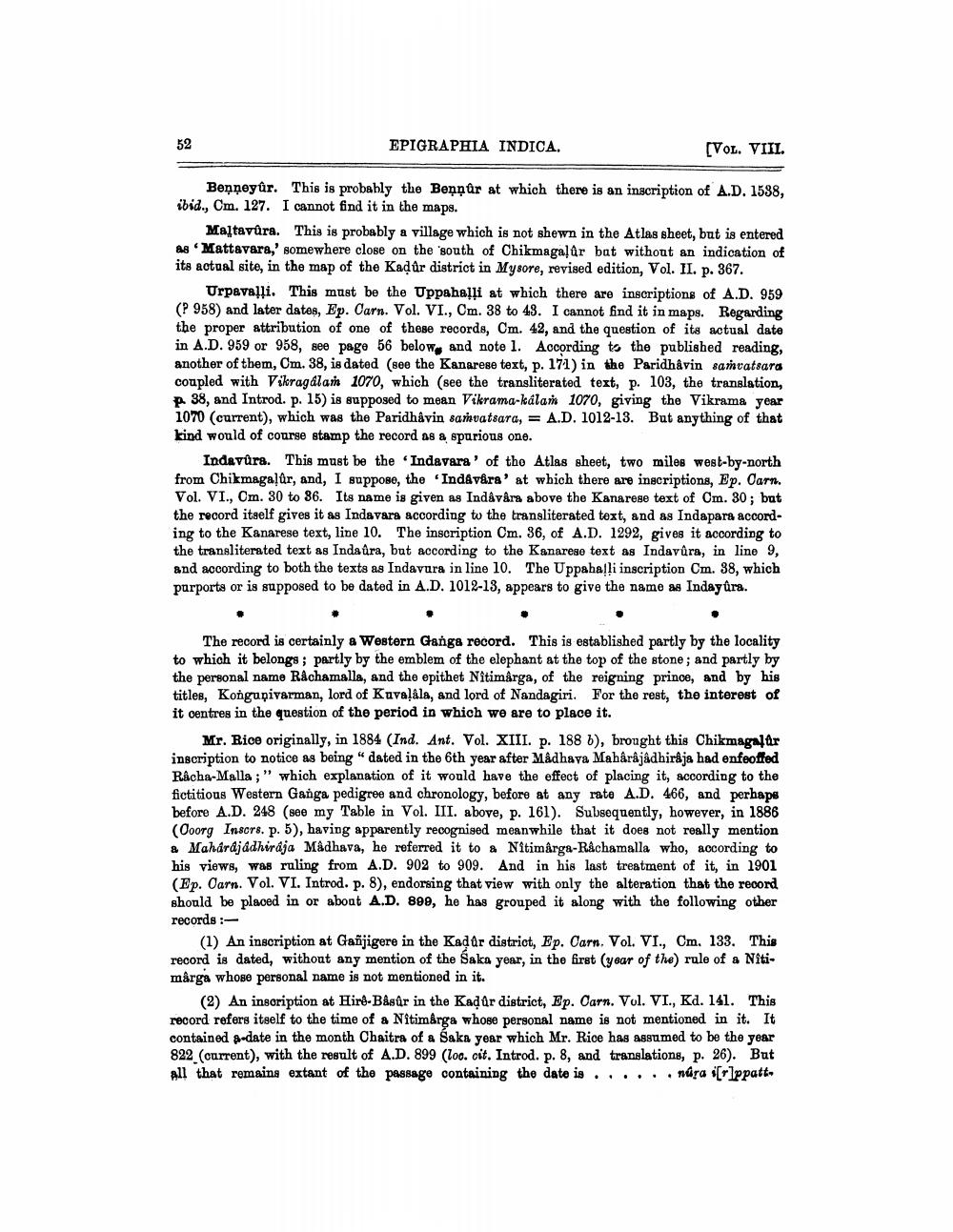________________
EPIGRAPHIA INDICA.
(VOL. VIII.
Bennoyur. This is probably the Bennur at which there is an inscription of A.D. 1538, ibid., Cm. 127. I cannot find it in the maps.
Maltavûra. This is probably a village which is not shewn in the Atlas sheet, but is entered as Mattavara,' somewhere close on the south of Chikmagalur bat without an indication of its actual site, in the map of the Kadûr district in Mysore, revised edition, Vol. II. p. 367.
Urpavalli. This must be the Uppahalli at which there are inscriptions of A.D. 959 (2 958) and later dates, Ep. Carn. Vol. VI., Cm. 38 to 43. I cannot find it in maps. Regarding the proper attribution of one of these records, Cm. 42, and the question of its actual date in A.D. 959 or 958, see page 56 below, and note 1. According to the published reading, another of them, Om. 38, is dated (see the Kanarege text, p. 171) in the Paridhävin saṁvatsara coupled with Vikragdlan 1070, which (see the transliterated text, p. 103, the translation,
38, and Introd. p. 15) is supposed to mean Vikrama-kalan 1070, giving the Vikrama year 1070 (current), which was the Paridhävin samvatsara, = A.D. 1012-13. But anything of that kind would of course stamp the record as a spurious one.
Indayûrs. This must be the Indavara' of the Atlas sheet, two miles west-by-north from Chikmagalur, and, I suppose, the 'Ind&våra' at which there are inscriptions, Ep. Carn. Vol. VI., Cm. 30 to 86. Its name is given as Indâvâra above the Kanarese text of Om. 30; bat the record itself gives it as Indavara according to the transliterated text, and as Indapara according to the Kanarese text, line 10. The inscription Cm. 36, of A.D. 1292, gives it according to the transliterated text as Inda üra, but according to the Kanarege text as Indavüra, in line 9, and according to both the texts as Indavura in line 10. The Uppahalli inscription Cm. 38, which purports or is supposed to be dated in A.D. 1012-13, appears to give the name as Indayûra.
The record is certainly & Western Ganga record. This is established partly by the locality to which it belongs ; partly by the emblem of the elephant at the top of the stone; and partly by the personal name Rachamalla, and the epithet Nîtimârga, of the reigning prince, and by his titles, Konguộivarman, lord of Kuva!åla, and lord of Nandagiri. For the rest, the interest of it centres in the question of the period in which we are to place it.
Mr. Rice originally, in 1884 (Ind. Ant. Vol. XIII. p. 188 b), brought this Chikmagalur inscription to notice as being "dated in the 6th year after Madhava Mahârâjâdhiraja had enfeoffed Racha-Malla ;" which explanation of it would have the effect of placing it, according to the fictitions Western Ganga pedigree and chronology, before at any rate A.D. 466, and perhaps before A.D. 248 (see my Table in Vol. III. above, p. 161). Subsequently, however, in 1886 (Ooorg Inscrs. p. 5), having apparently recognised meanwhile that it does not really mention a Maharajadhiraja Madhava, he referred it to a Nitimârga-Rachamalla who, according to his views, was ruling from A.D. 902 to 909. And in his last treatment of it, in 1901 (Ep. Oarn. Vol. VI. Introd. p. 8), endorsing that view with only the alteration that the record should be placed in or aboat A.D. 899, he has grouped it along with the following other records :
(1) An inscription at Gañjigere in the Kadar district, Ep. Carn. Vol. VI., Cm. 133. This record is dated, without any mention of the Saka year, in the first (year of the rule of a Nitimarga whose personal name is not mentioned in it.
(2) An inscription at Hiro-Båsûr in the Kadûr district, Ep. Carn. Vol. VI., Kd. 141. This record refers itself to the time of a Nitimârga whose personal name is not mentioned in it. It contained A-date in the month Chaitra of a Saka year which Mr. Rice has assumed to be the year 822 (current), with the result of A.D. 899 (loc. cit. Introd. p. 8, and translations, p. 26). But all that remains extant of the passage containing the date is ...... nura [rppatt




